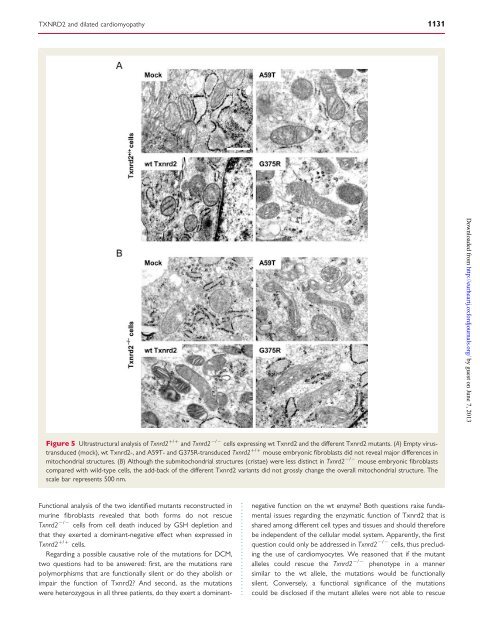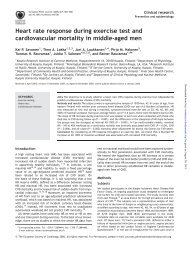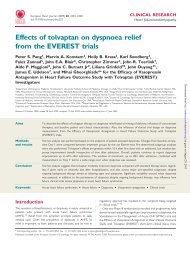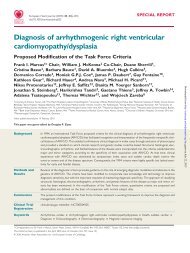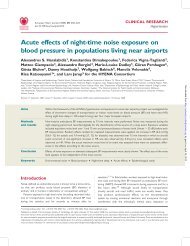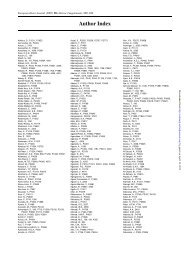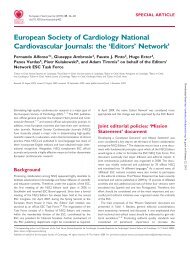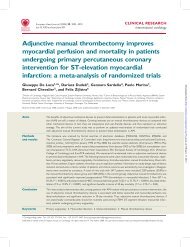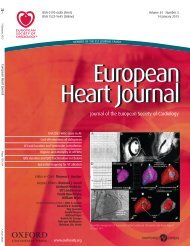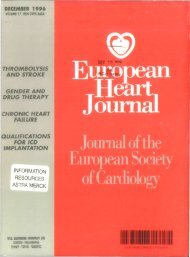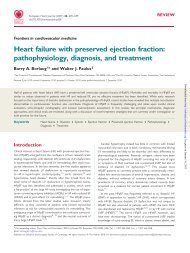Mutations in the mitochondrial thioredoxin reductase gene TXNRD2 ...
Mutations in the mitochondrial thioredoxin reductase gene TXNRD2 ...
Mutations in the mitochondrial thioredoxin reductase gene TXNRD2 ...
Create successful ePaper yourself
Turn your PDF publications into a flip-book with our unique Google optimized e-Paper software.
<strong>TXNRD2</strong> and dilated cardiomyopathy 1131<br />
Figure 5 Ultrastructural analysis of Txnrd2 +/+ and Txnrd2 2/2 cells express<strong>in</strong>g wt Txnrd2 and <strong>the</strong> different Txnrd2 mutants. (A) Empty virustransduced<br />
(mock), wt Txnrd2-, and A59T- and G375R-transduced Txnrd2 +/+ mouse embryonic fibroblasts did not reveal major differences <strong>in</strong><br />
<strong>mitochondrial</strong> structures. (B) Although <strong>the</strong> sub<strong>mitochondrial</strong> structures (cristae) were less dist<strong>in</strong>ct <strong>in</strong> Txnrd2 2/2 mouse embryonic fibroblasts<br />
compared with wild-type cells, <strong>the</strong> add-back of <strong>the</strong> different Txnrd2 variants did not grossly change <strong>the</strong> overall <strong>mitochondrial</strong> structure. The<br />
scale bar represents 500 nm.<br />
Functional analysis of <strong>the</strong> two identified mutants reconstructed <strong>in</strong><br />
mur<strong>in</strong>e fibroblasts revealed that both forms do not rescue<br />
Txnrd2 2/2 cells from cell death <strong>in</strong>duced by GSH depletion and<br />
that <strong>the</strong>y exerted a dom<strong>in</strong>ant-negative effect when expressed <strong>in</strong><br />
Txnrd2 +/+ cells.<br />
Regard<strong>in</strong>g a possible causative role of <strong>the</strong> mutations for DCM,<br />
two questions had to be answered: first, are <strong>the</strong> mutations rare<br />
polymorphisms that are functionally silent or do <strong>the</strong>y abolish or<br />
impair <strong>the</strong> function of Txnrd2? And second, as <strong>the</strong> mutations<br />
were heterozygous <strong>in</strong> all three patients, do <strong>the</strong>y exert a dom<strong>in</strong>ant-<br />
negative function on <strong>the</strong> wt enzyme? Both questions raise fundamental<br />
issues regard<strong>in</strong>g <strong>the</strong> enzymatic function of Txnrd2 that is<br />
shared among different cell types and tissues and should <strong>the</strong>refore<br />
be <strong>in</strong>dependent of <strong>the</strong> cellular model system. Apparently, <strong>the</strong> first<br />
question could only be addressed <strong>in</strong> Txnrd2 2/2 cells, thus preclud<strong>in</strong>g<br />
<strong>the</strong> use of cardiomyocytes. We reasoned that if <strong>the</strong> mutant<br />
alleles could rescue <strong>the</strong> Txnrd2 2/2 phenotype <strong>in</strong> a manner<br />
similar to <strong>the</strong> wt allele, <strong>the</strong> mutations would be functionally<br />
silent. Conversely, a functional significance of <strong>the</strong> mutations<br />
could be disclosed if <strong>the</strong> mutant alleles were not able to rescue<br />
Downloaded from<br />
http://eurheartj.oxfordjournals.org/ by guest on June 7, 2013


